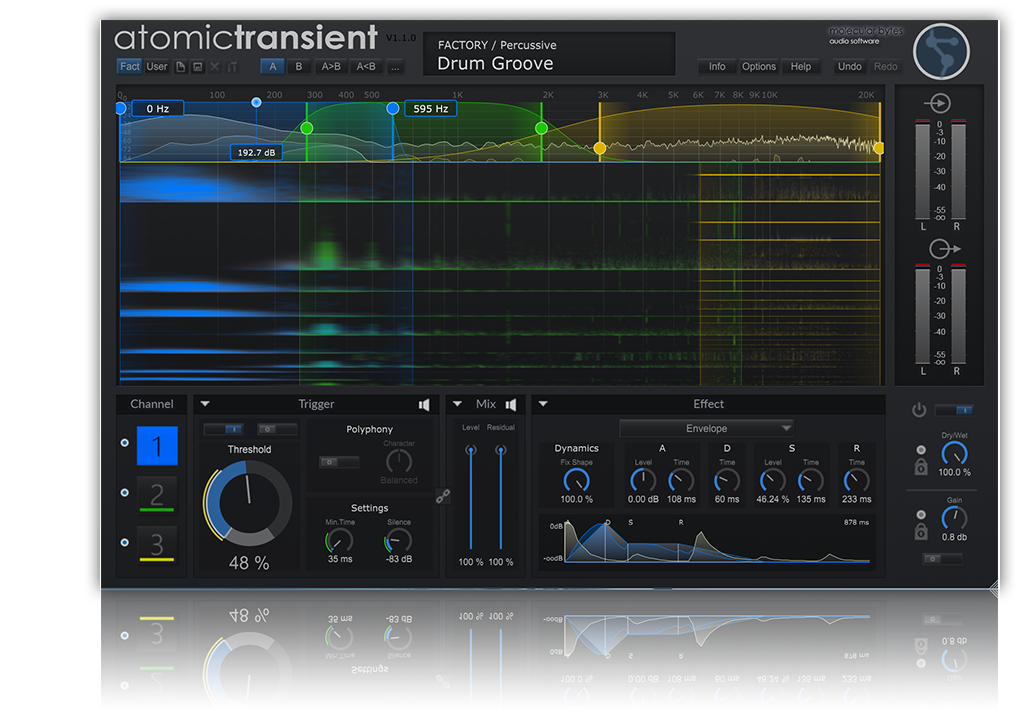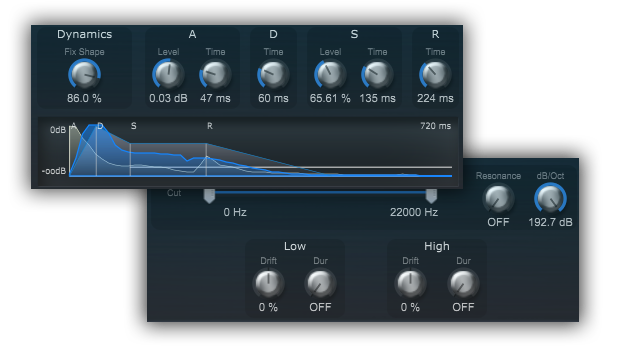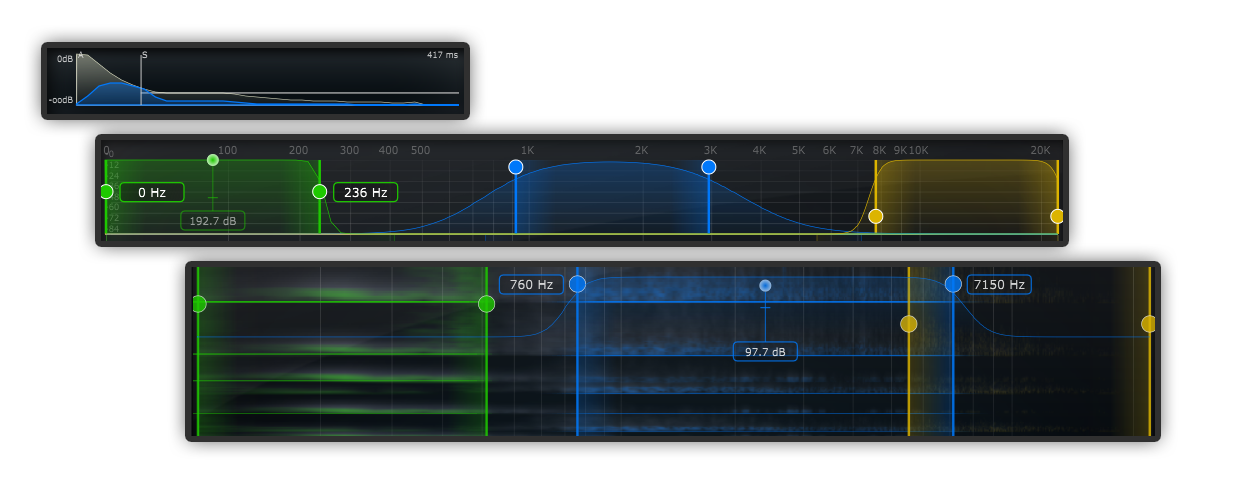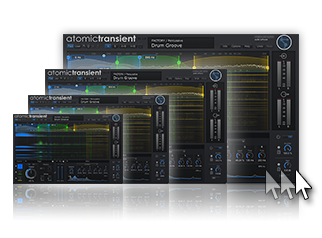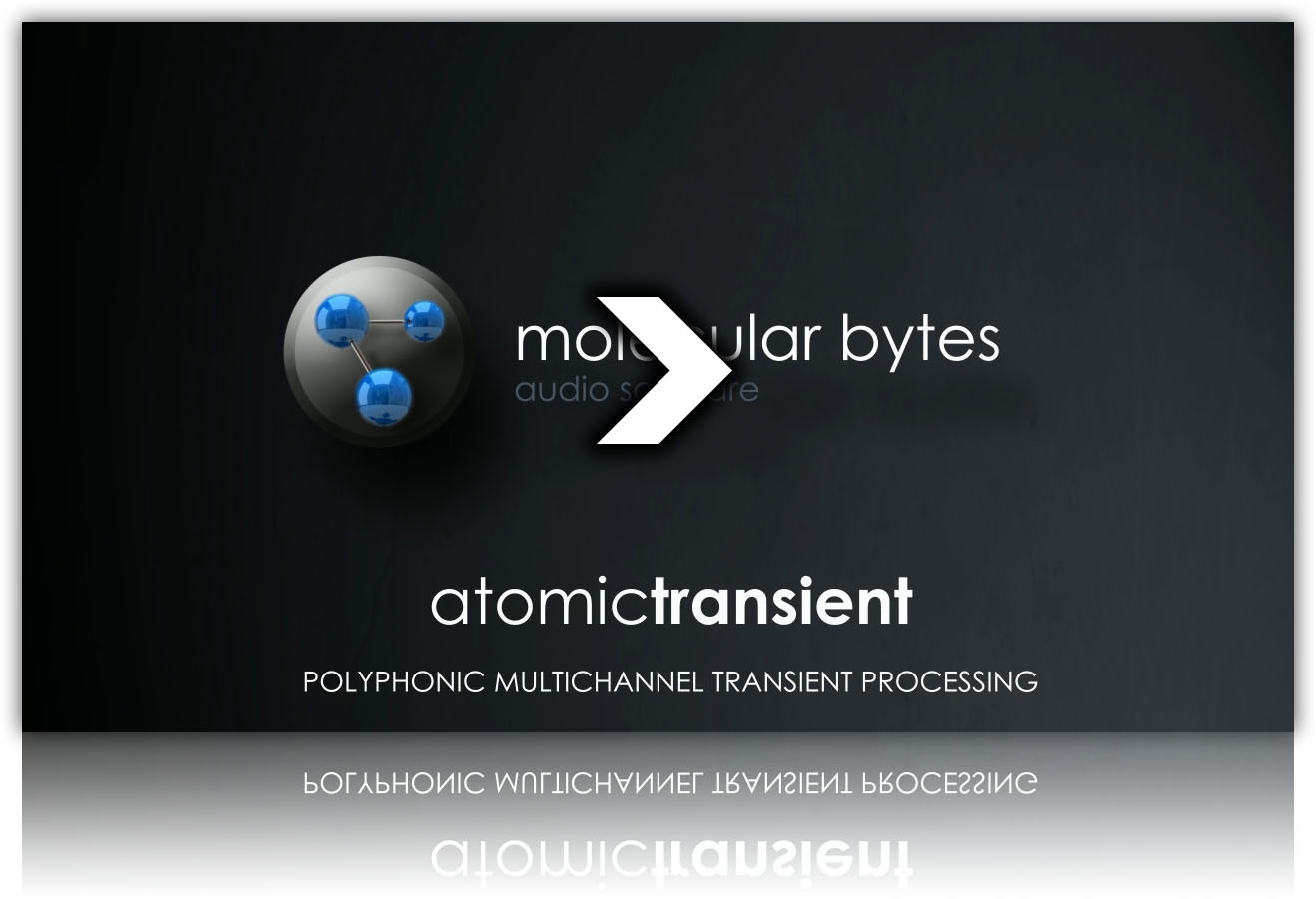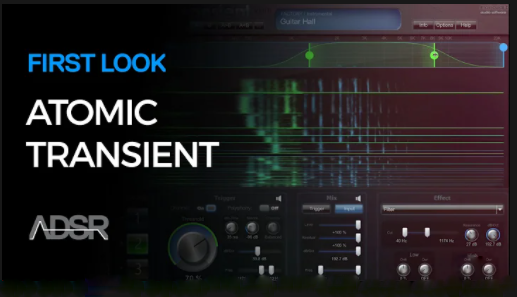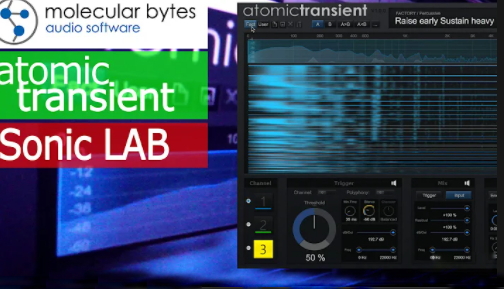What is polyphonic transient processing ?
Transients are the most expressive parts of an audio signal. They last only a few milliseconds and are mostly impulsive. For instance, the kick sound of a bass drum, the hit of a hi-hat with a stick or the hammer stroke of a piano. Mostly transients are attenuated or amplified by the attack parameter of a transient shaper.
The transients are followed by the actual sonorous sound of the instrument, like a piano, a guitar or a TomTom or bass drum. The sustain parameter is used to change this part of the sound. Current Transient Shapers change the dynamics of the entire signal and thus influence the full frequency spectrum:
The attenuation or amplification of attack and sustain always affects already sounding, polyphonic drums or previously played notes of an instrument. Notes played in succession are often not recognized at all. For example, a hi-hat lowered by attack would also lower a previously played cymbal, or a guitar tone raised with sustain and thus lengthened would also change a newly played polyphonic tone, since this is usually not recognized as a new tone.
It is even more significant when such Transient Shapers are applied to a mix: Raising or lowering transients - no matter whether they are percussion or the attack of a stringed instrument - will affect already sounding tones.
To demonstrate the behavior of polyphonic transient processing, we have played the notes A-C-E of an organ instrument one after the other and recorded once through current transient shapers and once through atomictransient as an effect plug-in. The pictures show the real spectral response of the individual notes (due to gain adjustment of the plugins, individual signals in the overall picture are stronger or weaker)
Original Sound
Three notes A-C-E are played at 1 second intervals. Each note begins with a transient.

Current Transient Shapers
- Second and third tone are not recognized and therefore played with original attack

Current Transient Shapers
- The amplified attack of the second tone also amplifies the already sounding first tone
- The third tone is not recognized and is played with the original tone

At this point the polyphonic mode of atomictransient works differently. Polyphonic audio material such as piano, guitar or complete sample loops and mixes can be processed polyphonic per channel:
By means of a special analysis, the tones occurring through a transient are divided into their frequency components of the overall signal and only changed partially. Polyphonic tones are mostly not influenced by each other and the effect processing of the envelope takes place separately for each individual tone.
Raising or lowering by attack or sustain only affects the played tone and all tones are altered independently of each other in their own envelope - this works for instruments as well as for drums. This is comparable to the specific modification of the overlapping notes of an instrument.
atomictransient (mono mode)
- amplified attack is recognized for all tones
- in mono mode, as with classic transient shapers, already sounding tones are also changed and the effect affects the entire frequency spectrum

atomictransient (poly mode)
- amplified attack is recognized for all tones
- in poly mode, only the tones that caused a transient are changed, since the effect only affects the frequency components of this played tone

With the flexibility of the Envelope effect, which can change the envelope of an instrument from attack, decay and sustain to several seconds up to release, you can, for example, assign a completely new envelope to an organ:
atomictransient (poly mode)
- amplified attack is recognized for all tones
- every note gets a new envelope, so that every note ends after 1.5 seconds

atomictransient (poly mode)
- amplified attack is recognized for all tones
- every note gets a new envelope, so that every note ends after 2 seconds

Polyphony with percussion patterns
atomictransient features up to three parallel processing channels. Each channel is processed independently of the others and contains all settings. By limiting the transient detection to a defined frequency range, the channel can, for example, only include certain bass or treble frequencies. If e.g. all 3 channels are used, different values for the envelope can be set for 3 separate drum tones. A bass drum, snare or hi-hat can thus trigger a specific transient and is then dynamically changed with the channel settings.
Polyphonic mode can also be used for each channel to separate individual drum sounds from a pattern or mixdown. In this case, only the tones that have triggered a transient are processed. Other tones (e.g. the hi-hat) that do not trigger a transient remain untouched or can be removed using the 'Residual' parameter.
The mixer parameters for each channel allow you to control the effect output and the frequency range of the effect. The 'Level' and 'Residual' parameters are used to modify the relationship between the effect and the original signal.
atomictransient therefore offers many new possibilities to change the dynamics of any audio material!
Basedrum, Clap, Hi-Hat and Cowbell unchanged
Filter of transient detection is set up to the Clap.
Sustain at 60%.
Filter of the transient detection is reduced to the basedrum.
Attack at +4dB, sustain and release set to 400ms.
Transient detection filter triggers on the cowbell.
Sustain is set to 0%.
